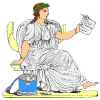|

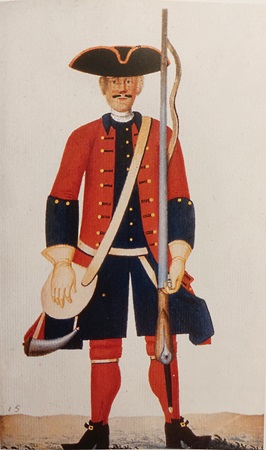
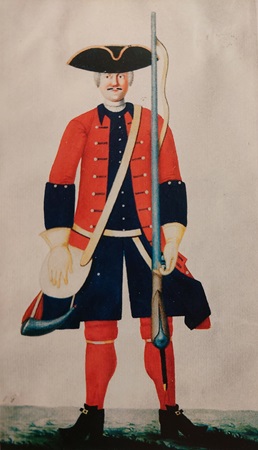
Drawings from 1728 by Worgewitz depicting a
Danish and a Norwegian artilleryman.
The artillery branch of Denmark-Norway's armed forces got its first
permanent organisation in 1684 and was then divided into three corps
(Denmark, Holstein and Norway) which until 1709 had separate uniforms. But
even after that year the uniforms could still be separate in minor details,
in some degree dependant on the availability of cloth.
The
artillery uniforms had the same pattern as the infantry uniform and for general
information on their appearance, please
read the page about the Danish
infantry.
|
|
Artillery Uniforms in General
Artillerymen were armed
with swords which were initially carried with shoulder belts, but which in
1703 were replaced with waist belts. Both were made of buff leather.
Until 1709, all three artillery corps had separate uniforms. However,
even after 1709 there were variations between the corps as the
officially mandated uniforms were not always those issued. See the
separate uniform accounts for each artillery corps to see which uniforms
are mentioned in the sources.
In 1709, the king decided
that all three artillery corps would have the same uniform, which would
consist of a red "surtout" with blue facings and a blue "livkjole" with
red facings. Exactly what is meant by surtout and livkjole at this time
is unclear because they actually refer to the same item of clothing, the
regular uniform coat. Surtout is just a newer French word that had come
into use around this time. It is possible that the surtout refers to an
overcoat that would be used in bad weather ("rain coat") and
which had recently replaced the sleeveless cassock in the Danish army.
If so, it is the same colour combination as in the uniform issued to the
Holstein Artillery Corps in 1701. It is also possible that the word
livkjole at this time referred to a vest, also called "camisole",
which was worn under the regular coat ("liv" and "kjole" literary means
"waist" and "coat".
The uniform regulation of
1711 stated that the entire army should have red coats and that the
facing colour of the artillery should be violet. Here, however, it
seems to be uncertain to what extent uniforms with violet colour were
actually issued. In Daniel Schorr's article (page 34) it is
mentioned that the Danish and Holstein corps probably had blue colour
instead because there was already blue cloth available and that this
possibly applied to the Norwegian corps as well. Karsten Skjold Peterson
has given various bids for the Danish Corps in his books. In 2005 he
stated that in 1711-1716 they had violet cuffs, but dark blue leg clothes
(breeches & stockings). In 2014, however, he had changed this so that the
cuffs, leg clothes wear and vest were dark blue 1710-1716.
With the introduction of the
1716 uniform regulation, however, it was definitely dark blue that was the
facing colour of the artillery, the regulation also stated that they should
have brass buttons and, like the rest of the army, have red leg clothes.
Worgewitz's drawings from 1728, which can be seen at the top, depict
exactly this model of uniform. Note that the artillerymen in Worgewitz's
drawings differ from other regiments in that they have turnbacks. Another interesting
difference, found only in a series of plates by Zimmer from 1730, is the
number of buttons on the double-breasted coat: the Danish corps had 2x10
buttons, the Holstein corps had 2x11, and the Norwegian corps 2x9
buttons.
I only have two pieces of
information about what colour the gun carriages had. According to
Daniel Schorr (page 34), who wrote only about the Norwegian army, the
gun carriages were red with the metal fittings painted yellow. This colour
combination is also mentioned in the article on the Scanian war by
Hasselager/Snorrason (page 49). |
|
Danish
Artillery Corps
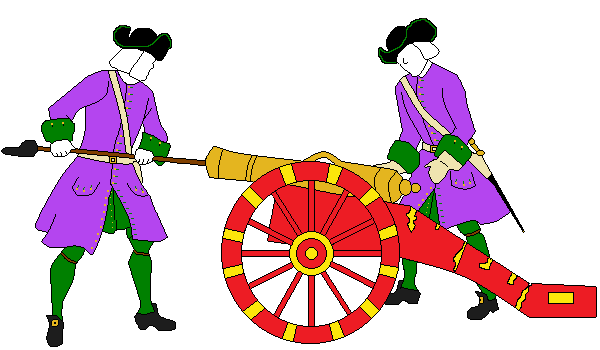
1691-1695 |
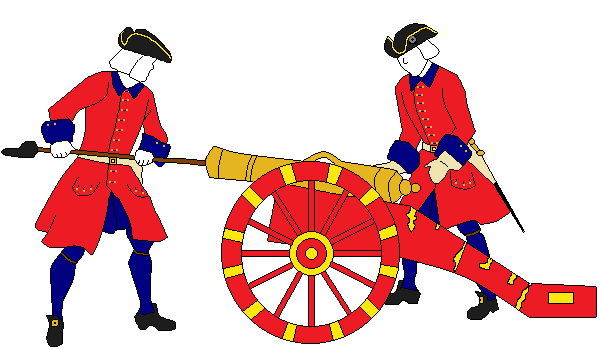
1710-1716 |
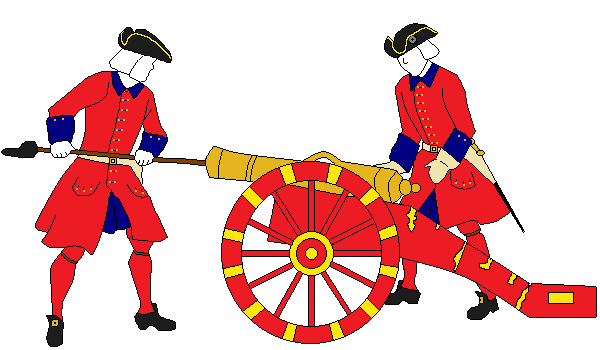
1716-1742 |
|
Violet coat with green
facings, lining, and leg clothes (breeches and stockings). |
Red coat with dark blue
facings and at least from 1711 yellow buttons. Dark blue vest and
leg clothes. |
Red coat with dark blue
facings and lining and yellow buttons, dark blue vest and red
leg clothes. The buttonholes were at least from 1728 dark blue. |
The above is the uniform information that Karsten Skjold Peterson has in
his book from 2014. According to Lars-Eric Höglund, the Danish artillery
had in 1683 violet (violet blue?) coats with red facings and lining. In
1700, according to him, they had blue coats with red. |
|
Norwegian
Artillery Corps
|

1685 |
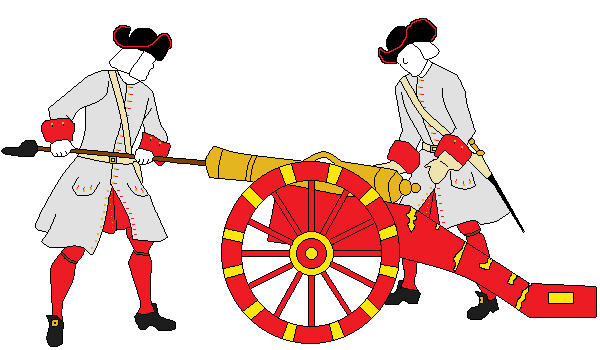
1697 |
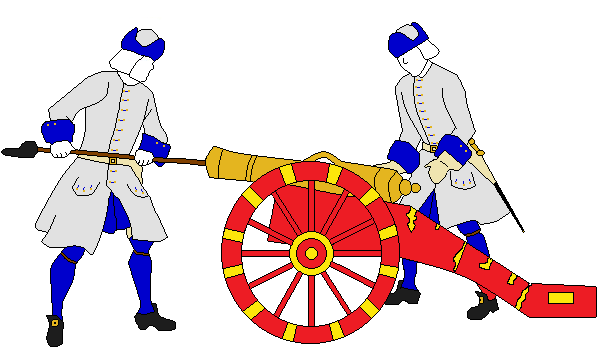
1710 |
|
Violet coat with green facings according to Daniel Schor and
Lars-Eric Höglund. Karsten Skjold Petersen does not mention this
uniform. |
Steel grey coat with red lining and cuffs, cloth cassock (cloak) in
the same colours. Black hat and white neckcloth. |
Steel grey coat with blue lining and vest. Leather breeches and riding cap or
karpus. A royal decree from 1709 that all artillery corps should adopt a common
uniform consisting of a blue coat and red surtout does not seem
to have been implemented. |
|
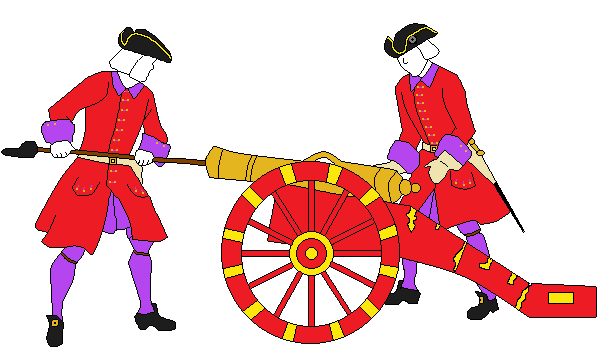
1711 (?) |
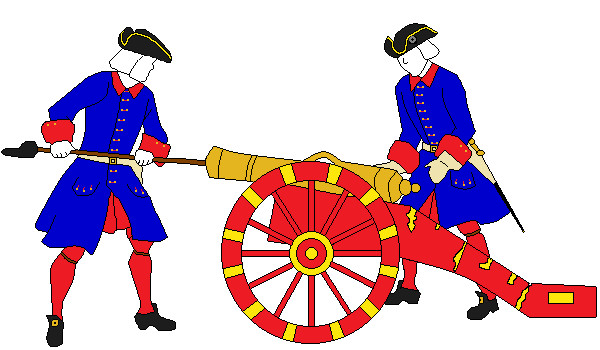
1718 |

1720 |
|
Red coat with violet lining and trousers. This is according to Daniel
Schorr, who mentions that all artillery corps were supposed to have
violet colour, but that a good supply of dark blue clothing meant that
the others probably used it instead and that the Norwegian corps might
also have done so. Karsten Skjold Petersen does not mention this
uniform. |
According to Daniel Schorr, Trondheim's company had blue coats with red
cuffs.
Karsten Skjold Petersen mentions a blue coat with red facings and lining.
But he does not specify if it was the whole corps or just one company. |
Red coat with blue facings and lining, and red stockings according to Daniel
Schorr. Karsten Skjold Petersen only mentions a red coat.
Lars-Eric Höglund has more details: dark blue vest and breeches as well
as yellow hat lace and brass buttons. |
In a drawing by Worgewitz
from 1728 (found at the top of this page) the Norwegian artillery still
wears the same uniform as in 1720. But the button colour is white even
though the hat galloon is yellow (these colours tend to match each other
at this time). However, Worgewitz's drawings often
contain dubious details, so they should be taken with a grain of salt.
Daniel Schorr also mentions that train personnel had
grey coats of vadmal with red cuffs and brass buttons in 1713.
|
|
References
Hasselager Olaf – Snorrason, Torstein. Danish Uniforms, Colours and Standards 1675-1679. (2000) *
Höglund, Lars-Eric – Sallnäs, Åke. Stora nordiska kriget 1700-1721, II. Karlstad (2003)
Schorr, Daniel. Notes on the Norwegian Army 1700-1720 (2008) *
Skjold Petersen, Karsten. Den danske hærs uniformer i 1700-tallet. Copenhagen (2005)
Skjold Petersen, Karsten. Kongens klæder. Copenhagen (2014)
Tuxen, A. P. – With-Seidelin C. L. Bidrag til den store nordiske krigs historie.
Copenhagen (1899-1934)
* = articles published on the now defunct website
www.northernwars.com |
